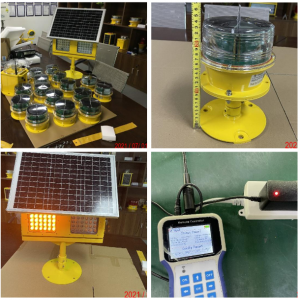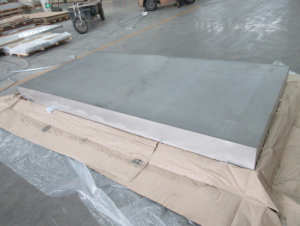 1.Appearance
1.Appearance
2.Quantity check
3.Material check
4.Size check
5.Weight check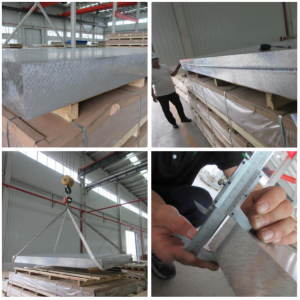
 1.Appearance
1.Appearance
2.Quantity check
3.Material check
4.Size check
5.Weight check
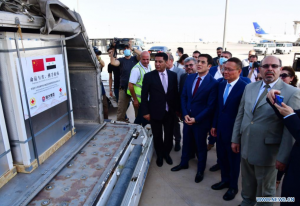
July 29 — The Syrian Health Ministry on Thursday received a batch of Chinese COVID-19 vaccines provided by the Red Cross Society of China.
Health Minister Hasan al-Ghabash attended the reception ceremony at the Damascus International Airport alongside Chinese Ambassador to Syria Feng Biao, as the Chinese embassy has supervised the delivery of the vaccines to the Syrian government.
During the ceremony, al-Ghabash expressed the Syrian government’s gratitude to China for sending the vaccines, which he hailed as effective and successful.
“We thank the government of the People’s Republic of China and the Chinese people for their important contributions in light of the spread of the COVID-19 virus in the world,” he said.
“This vaccine is one of the recognized and registered vaccines by the World Health Organization and it has proven its effectiveness and success in China and in other areas which have received this vaccine,” he said.
Feng said the new delivery reflects the friendship between the Chinese and Syrian people.
“Nowadays, the COVID-19 pandemic continues to spread around the world in tandem with the appearance of new variants of the virus, which makes it the most important duty for the world to exert efforts to counter the pandemic,” the Chinese ambassador said.
Feng called on all parties to abide by scientific principles in tracing the source of the virus and oppose politicizing this issue.
In April, Syria received a batch of Chinese vaccines as part of many medical donations offered by the Chinese government to Syria to deal with the pandemic.

As the rate of new cases fell by less than two percent over the past week, driven by a sharp drop in South Africa, 21 countries are experiencing a resurgence, three more than last week, warned Matshidiso Moeti, WHO regional director for Africa.
“Let’s be under no illusions, Africa’s third wave is absolutely not over. The small step forward offers hope and inspiration but must not mask the big picture for Africa,” she noted.
Africa continues to lag behind in terms of the COVID-19 vaccination, Moeti said, explaining that only about 1.5 percent of the continent’s population are fully vaccinated so far.
“African countries must go all out and speed up their vaccine rollouts by 5 to 6 times if they are to get all these doses into arms and fully vaccinate the most vulnerable 10 percent of their people by the end of September,” she said.
“Vaccines are key to saving lives and blunting the pandemic, but we must remain focused on controlling the disease until vaccination coverage is increased,” Moeti said.

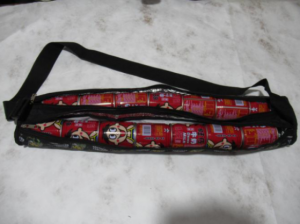
1.3M tape test
2.Bag strength check
3.Loading test (4.3kg)
4.Wet rub test
5.Zipper fatigue check
6.Odor check
7.Carton drop test
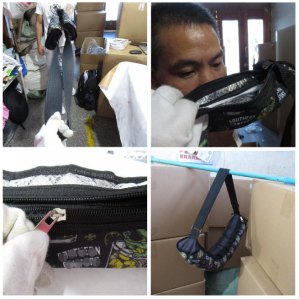
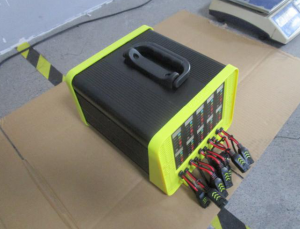
1.Basic function check (Functions on product specification work )
2.Power input test
3.Positive and negative reverse protection test
4.Aging test
5.Output current and voltage test
6.Barcode scanner test
7.3M tape test
8.Rub test
9.Internal test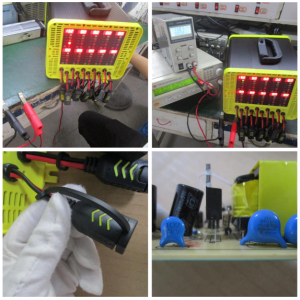

Since China joined the WTO in 2001, U.S. merchandise exports to China increased 187 percent. During the same period, U.S. exports to the rest of the world grew 38 percent.
The United States has a services trade surplus with China.
As the U.S. economy becomes increasingly globally integrated, the U.S. manufacturing base remains strong. While the U.S.’s manufacturing share of GDP is declining, America is still the world’s number one manufacturer, accounting for more than 20 percent of worldwide manufacturing value-added – that’s twice as much as Germany and more than 2.6 times as much as China. The U.S. manufactures more today than ever in its history – seven times as much real output as in 1950, with roughly the same number of workers as in 1950.
Increased international trade has raised real incomes, restrained prices, introduced greater product variety, spurred technological advances and innovation, and raised real living standards in the United States.
The annual payoff from trade liberalization to date is over $10,000 for an average American family of four. This includes the Tokyo Round, Kennedy Round and Uruguay Round, NAFTA and other U.S. free trade agreements.
The removal of remaining global barriers to trade in goods and services could generate an additional $600 billion in annual income for the United States. Most of these gains arise from liberalization of trade in services.
Approximately 57 million American workers are currently employed by firms that engage in international trade. These firms tend to be more productive, have higher employment growth and pay their workers higher wages than domestically-oriented firms.
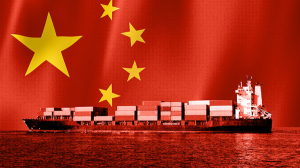
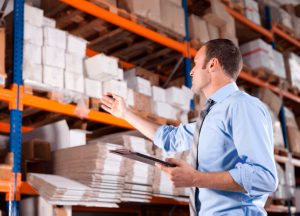
Pre-shipment inspection guards against nasty surprises which means that the goods are as per the quality standards prescribed in the product manual and are in working condition. This helps to build a strong brand image of the company in the long run. Being a part of the consumer goods industry, there are high chances that you have heard about a type of quality check called finished quality control and final random inspection. Though they appear as two different types, but in reality, it is a single quality inspection test.
What the Vendor Does during Pre-Shipment Inspection?
1. Manpower to help the Pre-Shipment Inspector:
The quality control inspector needs manpower to proceed with the inspection within the limited amount of time available.
Transport the randomly selected export cartons from the warehouse to the inspection room. Unpack the goods that the inspector arbitrarily selects from the selected export cartons. Repack the goods after the pre-shipment inspection.
The factory workers assistance ensures that the quality inspector focuses on his main job i.e. identifying defects and non-conformities.
2.Working Space for the Quality Inspector:
To select the cartons indiscriminately, they should be located in a wide area where the inspector can see all of them and easily select the cartons randomly, as requested by international standards. The room for inspection should be large enough, well-lit and clean and the factory is responsible for preparing the working environment accordingly in advance, so the inspector checking quality of the products focus on his main job without losing time.
The product packaging phase usually follows production and inspection can occur at various times before, during and after production. But in general, only pre-shipment inspection is conducted when at least 80% of the goods are finished and packed. It includes packaging checks as well.
Factory workers don’t normally pack units one by one as they come off the production line. Instead, they typically wait until production is close to finished before packing goods in bulk. Since it’s difficult to check packaging until so close to shipping, shipping delays often result when you find serious packaging issues during pre-shipment inspection.
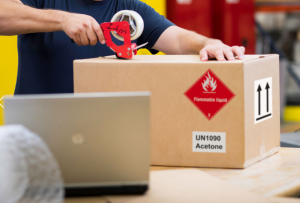
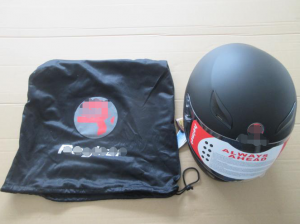
1.Logo/Printing 3M Tape test
2.Basic function check (Functions on product specification work )
3.Rubbing test
4.Tension test
5.Odor test
6.Carton dropping test
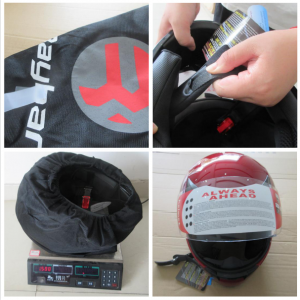
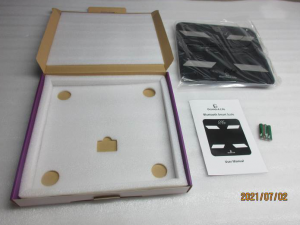
1.Logo/Printing 3M tape and 75% alcohol Rub test
2.Barcode and QR code Scanning test
3.Battery voltage test
4.Battery fitting test
5.15 degree Stability test
6.IOS system function test
7.Android system function test
8.Bluetooth connection test
9.5KG weight open test
10.Display unit conversion test
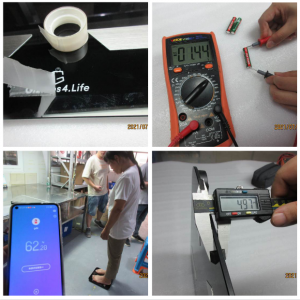
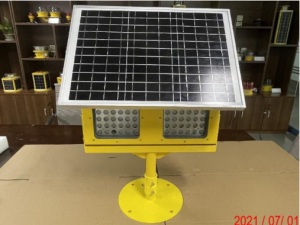
1.Appearance
2.Quantity check
3.Function test
4.Adapter charging test
5.Solar power supply test
6.Remote control function test
7.Assembly test
